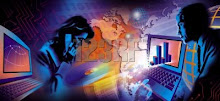However, pedagogically, a blended approach, which foregrounds conversational or social dialectic approaches to teaching and learning within its curriculum design and harnesses recently developed communication technologies to underpin its delivery and interaction, could be considered best practice for cultivating deeper and more integrated learning within a traditional University setting.
Ralph Young (Morrison, 2009), Microsoft Vice President, Woldwide Communications sector and John Seely Brown (2001) seem to support such a view. In a recent interview with James Morrison, Innovate editor-in-chief, Young highlighted a 2007 report entitled "Implementing Effective Approaches to Student Engagement and Retention in Australian Universities" which found that
- students characterized learning as a profoundly social experience and that social networking, e-mail, instant messaging, blogging, text messaging, and other connective technologies were seen as critical to this experience
- learning is not the same as teaching, "learning " and "teaching" must not be conflated and the technologies that students use to learn may not be the same technologies that professors use to teach.
Young goes on to stress that an emphasis on student engagement and on approaches which facilitate interest-driven and problem based learning as well as other pedagogical methods that focus on teaching students how to learn has to represent the cornerstone of any credible attempt to shape HE education in the future. There seems therefore to be room for conversational ideologies in Microsoft's vision of HE in the future as Young's comments align snuggly with the conversational theories and dialectic approaches highlighted in earlier blog posts here, including Enquiry based learning, Inquiry led curricula and Socratic Methods in addition to those posts alluding to the role of cyberspace and Web 2.0 conversational technologies. But, would Young actually agree? I've chanced my arm and emailed him to ask...... I wonder if he will reply?
Seely Brown (p.65) also acknowledges that learning is a remarkably social process which occurs as a result of a social framework that fosters learning and not as a response to teaching. Such social views of learning actively rely on personal interaction, communication and peripheral participation and so, in such a context, it is easy to see:- how virtual solutions and Web 2.0 technologies in particular could augment and indeed facilitate this type of learning; and
- how learning events which embed such conversational approaches could have the potentital to transform many of the interactions of researchers and students and of teachers and learners.
Young and Seely Brown agree that the virtual will never fully replace the physical university and that a balanced and blended "clicks and mortar" approach will prevail with virtual and face to face instruction running in tandem. They also seem to agree on the reasoning behind this. Young takes an economic, employer and socially driven stance revolving around student expectations and the need to address ciritical issues of scale, access and educational relevance whilst Seely Brown champions a blended approach in order to head off the possibility of a deeply devisive student body based upon affordability, with those who can afford it accessing the rich and respected resources available on campus and those who can’t making do with the internet. Seely Brown promotes a blended approach to ensure that more students have the opportunity to experience the best of both worlds, time spent on campus in physical communities and time spent online, whilst building the very skills required by employers when they move into the workplace.
Whilst initially sounding like another economic, institutional or even social egalitarian driver for the adoption of e-learning strategies, if we dig a little deeper we find that Seely Brown's blended approach is actually more fundamentally guided by its educationally based social learning aspirations and communicative, collaborative, creative and interactive core.
By capitalising on a University's unique selling points:
- its established and nurtured learning communities, and
- knowledge creation role
Seely Brown argues that a University based education can, via forming networked, distributed, collaborative communities of learners and harnessing a socially based blended approach to education, be distanced from the realm of a delivery service or from being a meer trafficker of information (p. 69). Moreover, and more crucially within my context, he goes on to argue that such an approach actually aligns not only with what universities do best and with what people percieve make them places worthy of huge investment but also, critically, with the natural ways that people learn.
By leveraging the possibilities that technology offers and capitalising on the recent trend for online social communication within today’s society as a whole, a blended approach combining both modern virtual and traditional HE learning environments could therefore embed pedagogically sound dialectic and conversational ideologies or methodologies which focus on developing inquiry led and 'in-action' critical thinking to offer a supportive educational environment infused with abundant opportunity for students to pursue and engage with interactive, participatory learning aligned to their interests and needs.
This brings the business of learning to the forefront once again and re-illuminates a clear "raison d'etre" for a University based education at a time when forces are pushing us to question the role of educational institutions today and in the future (KnowledgeWorks Foundation, 2009) and to create learning ecosystems to help face key educational challenges including:
- Creating learning environments that promote active learning, critical thinking, collaborative learning, and knowledge creation.
- Developing 21st century literacies (information, digital, and visual) among students and faculty.
- Reaching and engaging today's learner.
- Encouraging faculty adoption and innovation in teaching and learning with IT.
- Advancing innovation in teaching and learning with technology in an era of budget cuts
(Educause, 2009)
With Oxford University also 'peering into the future of learning' by looking into the use of Web 2.0 in University life and setting up a facebook group to discuss the implications for learning, the conversation is only just beginning........
REFERENCES
Educause (2009). The EDUCAUSE Top Teaching and Learning Challenges 2009. [online] Available at: http://www.educause.edu/eli/Challenges [Accessed 3rd June 2009]
Educause (2009). TLChallenges09. Project Wiki. [online] Available at: http://www.educause.edu/wiki/TLChallenges09?redir [Accessed 3rd June 2009]
KnowledgeWorks Foundation & Institute for the Future, 2009. 2020 Forecast: Creating the Future of Learning. [online] Available at: http://www.futureofed.org/pdf/forecast/2020_forecast.pdf. [Accessed 3rd June 2009]
Morrison, J., and Young, R. 2009. Success and sustainability in higher education: an interview with Ralph Young. [online] Innovate 5 (5). Available at: http://www.innovateonline.info/index.php?view=article&id=650 [Accessed 2nd June 2009]
Seely Brown, J (2001) Learning in the Digital Age. In the Internet and University: Forum 2001, Maureen Devlin et al. eds. Educause and the Forum for the Future of Higher Education, 2002. [online] Available at: http://net.educause.edu/forum/ffpiu01w.asp [Accessed 14th May 2009]




